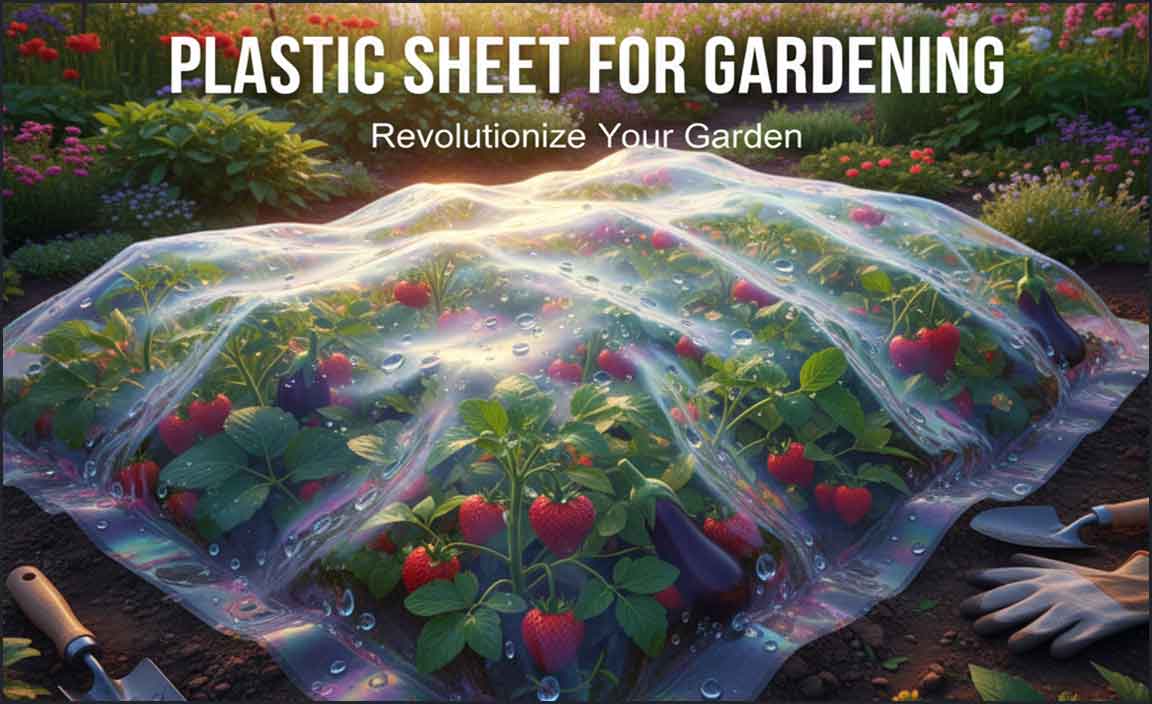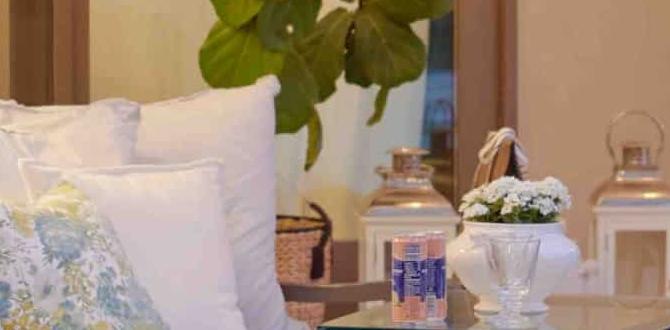Yes, small greenhouses for indoors are a genius solution for growing plants year-round, regardless of space or climate. They provide a controlled environment for starting seeds, growing herbs, or nurturing delicate plants, making indoor gardening accessible and successful for everyone.
Ever dreamed of a garden that thrives all year, no matter the weather outside? Or maybe you adore fresh herbs and vibrant veggies but thought you didn’t have the space? You’re not alone! Many of us face the challenges of limited outdoor growing seasons, unpredictable weather, or simply living in apartments with little natural light. But what if I told you there’s a fantastic way to overcome these hurdles and bring the joy of gardening right into your home?
Say hello to the magical world of small indoor greenhouses! These compact wonders are your secret weapon for gardening success. They create a perfect little ecosystem for your plants, protecting them and giving them exactly what they need to flourish. Whether you’re a complete beginner or have a bit of a green thumb already, an indoor greenhouse can transform your home into a lush, productive oasis.
Ready to discover how easy and rewarding indoor gardening can be? We’ll explore everything you need to know, from choosing the perfect small greenhouse to setting it up and watching your plants thrive. Let’s get growing!
Why a Small Greenhouse for Indoors? Your Indoor Garden Game-Changer
Thinking about bringing a greenhouse inside? That’s a brilliant idea! Small indoor greenhouses are more than just cute little plant homes; they’re powerful tools that make gardening accessible and successful for almost anyone. Let’s break down why they’re such a smart choice for your home.
Imagine being able to start your tomato seeds in January, have fresh basil for your pasta in deepest winter, or simply keep your favorite houseplants looking their absolute best, even when the heating is on and the air is dry. This is the magic that a small indoor greenhouse unlocks.
Benefits of Indoor Greenhouses: More Than Just Pretty
These little powerhouses offer a wealth of advantages for any budding indoor gardener:
- Extended Growing Season: Forget the limits of frost or short summers. With an indoor greenhouse, you can grow and harvest your favorite plants all year long. Start seeds early, grow cool-season crops indoors, or extend the life of your summer favorites.
- Controlled Environment: This is the big one! Greenhouses create a stable microclimate. They maintain consistent temperatures, humidity levels, and protect plants from drafts, pests, and diseases that can plague indoor plants. This is especially helpful for seedlings, which are delicate.
- Pest and Disease Protection: Keeping pests like aphids or spider mites away from your indoor plants can be a battle. A greenhouse acts as a physical barrier, significantly reducing the chances of infestation.
- Optimized Humidity: Many indoor environments, especially during winter, are very dry. This can be tough on plants that love moisture. A greenhouse traps humidity, creating a more comfortable and beneficial environment for them.
- Seed Starting Success: Germinating seeds requires specific conditions – consistent warmth and moisture. An indoor greenhouse provides this perfectly, giving your precious little seedlings the best possible start.
- Space Efficiency: Even a tiny apartment can house a small greenhouse. They come in various sizes, from tabletop units to lean-to styles that fit neatly in a corner or against a window.
- Energy Efficiency (for smaller units): Many small indoor greenhouses rely on ambient room light and temperature, making them incredibly low-energy. Larger ones might use simple grow lights, which come in energy-efficient LED options.
Types of Small Indoor Greenhouses for Your Home
When you’re looking for a small greenhouse for indoors, you’ll find a few popular styles. Each has its own charm and suits different needs and spaces.
- Tabletop Greenhouses: These are small, often clear plastic or glass cases that sit easily on a windowsill, desk, or shelf. They are perfect for starting a few seed trays or housing a small collection of herbs or succulents.
- Shelving Unit Greenhouses: These are essentially shelving units covered with a transparent, zip-up cover. They offer vertical growing space and are great for maximizing a small footprint. You can often fit multiple pots or seed trays on each shelf.
- Cold Frames (Indoor Adapted): While traditionally used outdoors, smaller, lighter cold frames can be placed on balconies, patios, or even sturdy indoor surfaces. They offer excellent light penetration and protection.
- Mini Greenhouse Kits: These are often DIY-friendly kits made from sturdy frames and plastic or polycarbonate panels. They can range from very small to medium-sized, offering a more permanent and expandable solution.
- Window Greenhouses: These are designed to attach to your window frames, either inside or outside. They leverage natural sunlight and are ideal for apartment dwellers with limited floor space.
Choosing Your Perfect Indoor Greenhouse: A Beginner’s Guide
Navigating the world of small greenhouses for indoors can be exciting! To make sure you pick the one that’s just right for you and your plant pals, let’s walk through the key things to consider. Think of it as finding the perfect home for your tiny green family.
1. Size Matters (But Not Always How You Think!)
First, take a good look at where you plan to put your greenhouse. Do you have a sunny windowsill? A corner of a room? Or maybe a small balcony?
Measure your space: Be precise! Measure the width, depth, and height of the area you have available. Don’t forget to consider if you’ll need clearance to open doors or access shelves.
Consider your plant needs: Are you just starting a few herbs, or do you plan to grow small vegetables or start many seedlings? This will dictate how much shelf space or height you’ll need.
Tabletop vs. Standing: Tabletop models are great for very limited spaces, while shelving units offer more room to grow upwards.
2. Material & Durability: What’s it Made Of?
The materials used will affect the greenhouse’s durability, insulation, and how well it lets in light.
Frames:
Metal (Steel, Aluminum): Strong and durable, great for larger or more permanent structures.
Plastic/PVC: Lightweight, affordable, and often rust-resistant. Good for many indoor models.
Wood: Can be very attractive but needs to be sealed to prevent moisture damage indoors.
Covering:
Plastic (Polyethylene): Common, affordable, and good for light. Look for UV-resistant types if it will be in direct sun for long periods.
Polycarbonate: More durable and offers better insulation than basic plastic. Often used in more robust kits.
Glass: Looks beautiful and allows maximum light, but can be heavy, breakable, and offer less insulation than plastic. It’s often found in more decorative tabletop models.
3. Light: The Sunshine Factor
Plants need light to grow. Where will your greenhouse sit, and how much natural light does it get?
Natural Light: South-facing windows usually offer the most light. East and west windows provide good morning or afternoon sun. North-facing windows are best for plants that prefer shade.
Artificial Light: If natural light is insufficient, you’ll need to consider grow lights. Many small greenhouses have space to mount or place small LED grow lights. Look for full-spectrum lights for best results. Check out resources like The Old Farmer’s Almanac on Grow Lights for more
information on choosing the right ones.
4. Ventilation: Letting Air In and Out
Good airflow is crucial to prevent mold and mildew and to ensure plants get fresh carbon dioxide.
Many indoor greenhouses have roll-up doors or unzip panels that allow for easy ventilation.
Some may have small vents.
Shelving unit greenhouses with fabric covers often allow for decent air exchange through the material itself.
5. Ease of Assembly and Use
As a beginner, you want something that’s easy to set up and maintain.
Assembly: Read reviews! Some are “no-tool” assembly, while others require basic tools.
Access: Can you easily water your plants? Reach the back shelves? Are the doors easy to open and close?
* Cleaning: How easy is it to wipe down the panels or shelves?
Setting Up Your Small Greenhouse: A Step-by-Step Guide
You’ve chosen your perfect small indoor greenhouse – hooray! Now comes the fun part: setting it up and getting it ready for your green buddies. Don’t worry, it’s simpler than you might think. Follow these steps, and you’ll have your indoor garden sanctuary ready in no time.
Step 1: Choose the Prime Location
This is the most important step for your plants’ happiness. Think about light and temperature.
- Sunlight is Key: Find the spot in your home that receives the most natural light. A south-facing windowsill is often ideal, but an east or west window can also work well. If you don’t have a lot of natural light, don’t despair! We’ll address grow lights in Step 4.
- Stable Temperature: Avoid areas with extreme temperature fluctuations. This means staying away from drafty windows or doors, heating vents, or air conditioners. A consistent room temperature is best.
- Accessibility: Make sure you can easily reach your greenhouse to water, tend to your plants, and harvest.
Step 2: Prepare Your Greenhouse Structure
This might involve assembling a frame or simply unfolding your unit. Read the manufacturer’s instructions carefully.
- Assemble the Frame: If your greenhouse comes in pieces, follow the instructions to build the frame. Ensure all connections are secure.
- Attach the Cover: Carefully fit the plastic or polycarbonate cover over the frame. Make sure it’s taut and all zippers or fasteners work smoothly.
- Position Shelving: If it’s a shelving unit, place the shelves at your desired heights. Ensure they are level and stable.
Step 3: Add Your Growing Medium and Containers
Now it’s time to get your plants settled!
- Containers: Use pots, seed trays, or grow bags. Ensure they have drainage holes to prevent waterlogging.
- Potting Mix: Use a good quality potting mix suitable for your plants. For seed starting, a lighter seed-starting mix is best. You can find great resources on soil types at university extension sites like Purdue University Extension.
- Arrange Your Plants: Place your pots and trays onto the shelves or base of the greenhouse. Consider giving taller plants more space or placing them on top shelves.
Step 4: Implement Lighting (If Needed)
If natural light isn’t enough, it’s time for artificial help.
- Choose Your Lights: Small LED grow lights are energy-efficient and effective. They come in various forms – strip lights, bulbs, or small clamp lamps.
- Position the Lights: Hang or place your grow lights above your plants. The ideal distance depends on the light’s strength and your plants’ needs. Generally, keep them 6-12 inches above the foliage.
- Timer is Your Friend: Use a timer to ensure your plants get consistent light, mimicking natural day-night cycles. Most plants need 12-16 hours of light per day.
Step 5: Water Wisely and Monitor Humidity
Your greenhouse will help retain moisture, so adjust your watering habits.
- Check Soil Moisture: Instead of watering on a schedule, check the soil by sticking your finger about an inch deep. Water only when the top inch feels dry.
- Watering Technique: Water the soil directly, trying to avoid getting water on the leaves, especially if humidity is already high.
- Humidity Control: A greenhouse naturally increases humidity. If it seems too high (condensation is dripping excessively), open the vents or door for a few hours to let it air out. A small hygrometer (humidity meter) can help you keep track.
Step 6: Ventilation and Air Circulation
Airflow is vital for healthy plants.
- Open Up: Even on cool days, open your greenhouse for a few hours to allow fresh air exchange. This helps prevent fungal diseases and strengthens your plants.
- Fan Power (Optional): For larger indoor setups or if you notice stagnant air, a small clip-on fan can provide gentle air circulation.
Step 7: Observe and Adjust
Gardening is a journey of learning and observation.
- Watch Your Plants: Look for signs of stress – wilting, yellowing leaves, or stunted growth.
- Adjust as Needed: If a plant looks unhappy, consider if it’s getting too much or too little water, light, or if humidity is an issue.
- Enjoy the Process: Celebrate the small wins and learn from any challenges. That’s what being a gardener is all about!
What Can You Grow in Your Small Indoor Greenhouse?
The possibilities are truly delightful! A small greenhouse for indoors opens up a world of growing options that might not be possible in your home or climate otherwise. Whether you’re hoping to liven up your kitchen counter or start a more ambitious indoor garden, here are some fantastic choices:
Herbs: Your Culinary Companions
Fresh herbs elevate any meal, and growing them indoors is incredibly rewarding. Most herbs thrive in the controlled environment of a small greenhouse.
- Culinary Staples: Basil, parsley, cilantro, chives, mint, oregano, thyme, rosemary, and sage are excellent choices. They generally prefer consistent moisture and good light.
- Specialty Herbs: Consider growing less common herbs like dill, tarragon, or even small chili peppers.
- Benefits: Having fresh herbs at your fingertips year-round means no more last-minute grocery runs and incredibly fresh flavors for your cooking.
Leafy Greens: Quick and Nutritious
Leafy greens are often fast-growing and don’t require a lot of vertical space, making them perfect for small greenhouses.
- Lettuces: Many varieties of loose-leaf lettuce can be harvested multiple times.
- Spinach & Arugula: These peppery greens grow relatively quickly and add a nutritious punch to salads and meals.
- Kale & Swiss Chard: While they can grow larger, baby leaves can be harvested for salads, or you can grow smaller varieties.
- Microgreens: These are baby seedlings harvested just after the first true leaves appear. They are packed with nutrients and flavor and grow incredibly fast, often ready in 1-3 weeks. A small greenhouse is ideal for maintaining the perfect humidity and temperature for microgreen trays.
Vegetables: Small Wonders
While you won’t be growing giant pumpkins, many vegetables can be successfully cultivated in a small indoor greenhouse.
- Tomatoes: Choose “dwarf” or “bush” varieties specifically bred for containers and smaller spaces. They will need good light and support as they grow.
- Peppers: Similar to tomatoes, smaller pepper varieties (like chili peppers or some bell peppers) can do well.
- Radishes: These are fast-growing root vegetables that don’t need much depth.
- Scallions/Green Onions: Easy to grow, and you can even regrow them from kitchen scraps in water before transplanting to soil.
Flowers and Ornamentals: Adding Beauty
Don’t forget the aesthetic appeal! A small greenhouse can be a haven for beautiful blooms and foliage.
- Seedlings for Outdoors: Get a head start on your outdoor flower garden by starting seeds like marigolds, zinnias, petunias, or pansies weeks before the last frost.
- Houseplant Propagation: Propagate cuttings from your existing houseplants. A greenhouse creates the high humidity many cuttings need to root successfully.
- Air Plants and Tillandsias: These unique plants love high humidity, making a greenhouse an ideal spot for them.
- Orchids and Tropicals: Many orchids and tropical plants thrive in humid, stable conditions that an indoor greenhouse can provide.
Maintaining Your Indoor Greenhouse Garden: Keeping Things Thriving
Once your little green haven is set up and your plants are settling in, a bit of regular care will ensure they keep flourishing. Don’t worry; maintaining a small indoor greenhouse is quite manageable, even for beginners! It’s all about consistent, gentle attention.
Watering Wisdom
As mentioned, your greenhouse will help retain moisture, so overwatering is a common pitfall. Always check the soil before you water.
- The Finger Test: Stick your finger about an inch deep into the soil. If it feels dry, it’s time to water. If it still feels moist, hold off.
- Watering Method: Water the soil at the base of the plant, not the leaves. This helps prevent fungal diseases.
- Drainage is Crucial: Ensure all your pots and trays have drainage holes,



